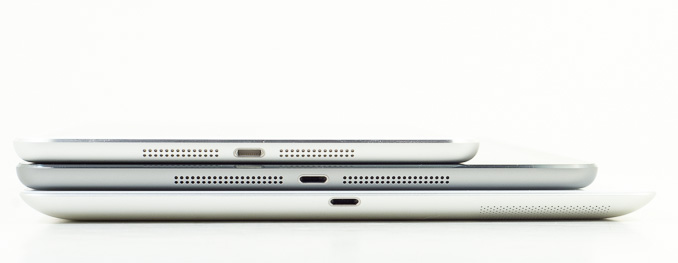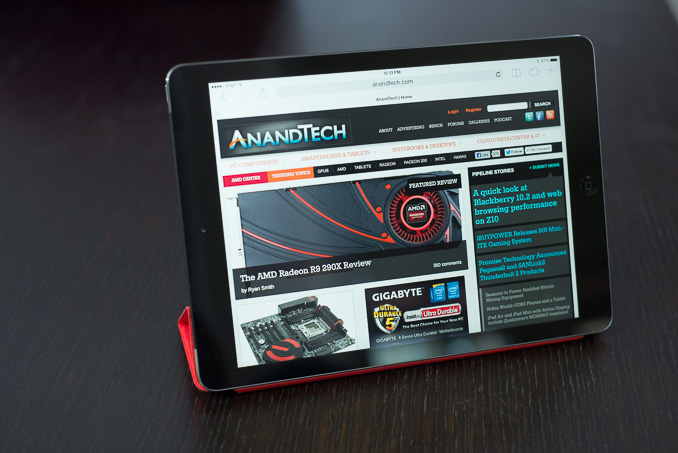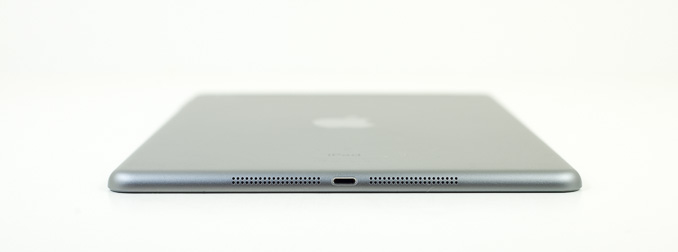The iPad Air Review
by Anand Lal Shimpi on October 29, 2013 9:00 PM ESTFinal Words
Two weeks ago I had all but written off the bigger iPad. It was too bulky and just no where near as portable as the iPad mini. Once the latter gets a Retina Display and equal hardware across the board, why would anyone consider the bigger model?
The iPad Air changed my perspective on all of that. It really does modernize the big iPad. While I suspect there are still going to be a lot of users who prefer the smaller form factor of the iPad mini with Retina Display, I do feel like there are those users who will continue to appreciate all of the benefits that go along with having a larger display. Text is easier to read, particularly on desktop versions of websites. Photos and videos are larger and thus more engaging as well. In the past there was this complex matrix of tradeoffs that you had to make between iPad and iPad mini. This generation, Apple does away with all of that.
All you need to do is pick your screen size. If you prefer the 9.7-inch form factor of the original iPad, the Air gets you as close as possible to a mini without giving up that display size.

From top to bottom: iPad mini, iPad Air, iPad 4
The name does the product justice in this case. In two hands or lightly propped up against something (palm, legs, chest), the iPad Air feels incredibly light - the weight just seems to disappear. The larger chassis doesn’t feel very dense at all. The in-hand feel of the device is really unlike any other iPad. It feels like a lightweight slate, rather than a heavy computing device. This is the iPad that Apple likely wanted to launch on day 1, it just took a bit over three years to get here.
Build and material quality are of course excellent. The iPad Air borrows much of the design language from the iPad mini, and makes the transition to a larger display quite nicely. The Air ends up looking a lot more modern than its predecessor.
Despite making the transition to a thinner touch and display stack, the iPad Air’s display is every bit as good as previous Retina Display iterations. Color accuracy remains best in class, delivering an out of box display experience that’s better than most systems, even at substantially higher price points. The only thing that the iPad Air leaves me wanting on the display front is a lower reflectance stack. Laminating the cover glass to the LCD panel is something that Apple does on both the iPhone and iMac, it’s time that the same feature is brought down to the iPad.
Apple’s decision to unify silicon across the iPhone 5s, iPad Air and iPad mini with Retina Display is an interesting one, but ultimately it doesn’t come with any real tradeoffs for iPad owners. Apple’s own 64-bit Cyclone cores are incredibly powerful, even more so than I originally expected when I reviewed the iPhone 5s. Apple seems to have built a bigger, higher performance CPU architecture than any other ARM player, including ARM itself. The design isn’t perfect, but it’s a completely different caliber performer than anything else it competes against. As such, Apple was completely justified in putting the A7 in both the iPhone 5s and the iPad Air. If anything, I’d argue that it might be overkill for the 5s given the device’s smaller battery, but my sensibilities soon get the best of me and remind me that more performance on tap is never a bad thing.
On the GPU front, Apple does increase performance over the iPad 4 as well - despite having a narrower memory bus. The increase in performance ranges from 40 - 70% depending on workload. I suspect we’re beginning to see some of the limits of 28nm here as Apple would’ve traditionally gone for an even larger GPU.
Despite having a smaller/thinner/lighter battery, battery life improves across the board compared to the 3rd and 4th generation iPads. Battery life in our web browsing, video playback and gaming workloads is better than either of the previous two iPads. Only the iPad 2,4 was able to deliver better battery life, but nothing with a Retina Display can match the iPad.
Cellular integration remains awesome on the iPad Air. With a single SKU covering 34 countries and no network operator lock, at least for those devices sold in the US, the LTE iPad Air is amazingly flexible from a network portability standpoint.
Improvements around the edges are nice as well. The inclusion of a second microphone can improve FaceTime HD calls in noisy environments, and faster WiFi is a nice addition.
My only complaints are limited to iOS 7, memory size and pricing. It’s clear that even on the fastest hardware Apple has to offer, iOS 7 isn’t always super smooth (particularly when using multitasking gestures to switch between apps) on an ultra high resolution device. The move to a 64-bit OS and applications makes a lot of sense, but with no corresponding increase in DRAM size Apple creates additional memory pressure on all of the A7 enabled devices. Finally, I’d love to see Apple update the default iPad configurations. Although 16GB is fine for a device that’s not going to be storing a ton of photos/videos locally, it would really be nice to get at least 32GB on the entry level iPad. The first complaint I suspect will be addressed over time. The second is a reality we just have to live with unfortunately, and the third won’t change until market dynamics force it to.
The iPad Air is the most significant upgrade to the 9.7-inch iPad in its history. It’s lighter, more portable, more usable and faster than any previous iPad. It doesn’t fundamentally change what you can do with a tablet, but if you’re in the market for one the iPad Air really is the best iPad to date. Competition is definitely more stiff among the smaller tablets thanks to the Nexus 7, but in the nearly 10-inch tablet space it seems like Apple is going to continue to enjoy a great position there.












444 Comments
View All Comments
doobydoo - Friday, November 15, 2013 - link
The hardware in the HDX is slower, and it is finished in plastic. So which part was inaccurate?melgross - Wednesday, October 30, 2013 - link
There is no such thing as 100% RGB gamut. Which gamut are you talking about? sRGB? Adobe 1998 RGB? Pro RGB? There are a lot of RGB standards out there.Theard - Wednesday, October 30, 2013 - link
what Cindy implied I didn't even know that people can earn $6894 in four weeks on the computer. look at this site ... jobs23.comLizbeth - Sunday, November 3, 2013 - link
and is several price points less that the ipad airKrysto - Wednesday, October 30, 2013 - link
> is probably the higher clocked Z3770I don't see that in any tablets today, let alone smartphones. So don't say it like that, as if it's already happened. As it is, Intel's chips aren't very competitive, in both CPU and GPU performance.
> while Qualcomm will probably pass Apple's GPU early next year.
They are equal right now, at least in smartphones. The others, perhaps with the exception of Nvidia, don't really make separate "tablet chips". They make one chip for both smartphones and tablets.
Speedfriend - Wednesday, October 30, 2013 - link
"As it is, Intel's chips aren't very competitive, in both CPU"You obviously have a problem reading, given the Transformer T100 which is very close to the iPhone 5S and iPad Air in the benchmarks above, uses the Atom Z3740, which is only the second fastest. So the Z3770, which is clocked 33% higher, should be at least equal if not better than A7 in CPU benchmarks.
How in your mind that equates to not competitive I don't know..
Homeles - Wednesday, October 30, 2013 - link
Not to mention that a lot of A7's strength isn't in the silicon, it's in the software stack on top of it. All of the CPU benchmarks are done through the stock web browser -- that's something Apple can fine tune, while Intel cannot. Therefore, the A7 outperforming Atom doesn't point to Atom being weaker at a silicon level, and instead shows the advantages of being able to hand tune your OS and applications and squeeze more out of your hardware.raptorious - Wednesday, October 30, 2013 - link
I'll give you one reason: the fact that Anand omitted the iPad 4 from the latency graph in the "An Update on Apple’s A7: It's Better Than I Thought" page. Why is the iPad 4 in the bandwidth graph and not in the latency graph. I'll tell you why: because the iPad 4 has better latency and Anand doesn't want to make the A7 look bad, so he left it out. No bias? Right.syedjalalt - Tuesday, November 5, 2013 - link
Apple iPad is a great product. No doubt. The word selection for writing such important reviews has been good here. IF you go The Verge and see the iPad review, you will notice how biased and predictable they have become. Nilay Patel doesn't know anything. The guys @verge always mock Android and especially Samsung.Last year's Nexus 4's review score had 8 for camera and 9 for ecosystem(as far as I remember). This year, ecosystem is 8 and camera is 5. Great!!!1
doobydoo - Friday, November 15, 2013 - link
Yep it's ridiculous that the Nexus 4 got 8 for camera. Should have been 3/4.Ecosystem scores can vary over time so don't see the problem there. Android hasn't moved on much in the past year.